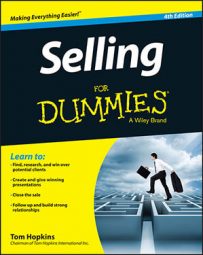To start down the road to sales success, you need to know how to make a good first impression, ensure that your prospective clients need what you have, give fantastic presentations, address client concerns, and close sales.
Meeting sales prospects for the first time
When you meet prospective clients during the selling cycle — or anyone, for that matter — for the first time, your goal is for them to like and trust you. You can accomplish that goal and be on your way to making a sale by completing the following steps, in this order:
-
Smile, deep and wide.
-
Make eye contact.
-
Offer a greeting.
-
Shake hands.
-
Offer your name and get the prospect’s name.
Long-term relationships begin in the first ten seconds.
Qualifying your prospective clients during the selling cycle
When you first meet with prospective clients, you need to qualify them — in other words, you need to see whether the product or service you sell meets their needs.
To help you remember what to ask during this stage of the selling cycle, use this creatively spelled acronym — NEADS:
-
N: What does your prospect have now?
-
E: What does your prospect enjoy most about what she has now?
-
A: What would your prospect alter or change about what she has now?
-
D: Who is the final decision-maker?
-
S: Tell your prospect of your goal to help her find the best solution.
Making winning sales presentations
People don’t buy logically. They buy emotionally and then defend their decisions with logic. Your sales presentation must not only capture and hold the attention of potential clients but should also involve as many of their senses as possible.
These tips can help you make an effective sales presentation:
-
Never give your prospect something to read until it’s time to read it.
-
Keep your presentation to 17 minutes (people tend to lose interest in anything after this time frame). It should run longer only because your prospect is actively involved and asking questions.
-
If there’s a break in your presentation for any reason, do a brief recap when you begin again to get your prospect back to the same emotionally involved point he was at before the break.
-
Let the product be the star by getting yourself out of the way. Don’t stand between your prospect and the product. Get the prospect actively engaged with the product if at all possible. Let him handle it, push buttons, move levers, whatever is appropriate.
-
Salt your presentation with your prospect’s lingo. For example, if you’re selling window coverings to an architect, use the industry names for the styles of windows or other features of her home or office.
Handling objections as you sell
An important step in the selling cycle is listening to and responding to your prospect’s concerns and objections. Here are the steps to take when a person objects to something about the product or service you’re selling:
-
Hear the prospect out.
Don’t be too quick to address every phrase your prospect utters. Give him time; encourage him to tell you the whole story behind his concern. If you don’t get the whole story, you won’t know what to do or say to change his mind.
-
Feed the objection back.
By rephrasing what your prospect’s concerns are, you’re asking for even more information. You want to be sure that he’s aired it all so that no other concerns crop up after you’ve handled this one.
-
Question the objection.
This step is where subtlety and tact come into play. Be sure to find out what feeling is behind that objection and reassure your prospect that your product or service is right for him.
-
Answer the objection.
When you’re confident that you have the whole story behind your prospect’s concern, you can answer that concern with confidence.
-
Confirm the answer.
You confirm your answers simply by saying, “That answers your concern, doesn’t it, Mr. Parker?” If you don’t complete this step, the prospect very likely will raise that objection again.
-
Change gears with “By the way. . . .”
By the way are three of the most useful words to move beyond the concern. Use these words to change gears — to move on to the next topic. Take a conscious, purposeful step back into your presentation.
Quick pointers for closing any sale
Most sales are lost because salespeople didn’t clearly ask for the business or asked at the wrong time. If your product or service has proven to be truly a good decision for your client, it’s your obligation to ask them to own it!
Develop your closing instinct with the help of these guidelines:
-
When you feel the client warming up to the sale by asking more questions, leaning forward, or touching the actual product, take his temperature by saying something like this: “Mr. Barnes, tell me, how are you feeling about all of this so far?”
-
Have at least six closing strategies in your arsenal because most clients dodge making the commitment five times.
-
Close with sincerity and empathy for their situation. For example: “Mr. and Mrs. White, I can appreciate your excitement about finally having a backyard pool of your own so you can swim with your family anytime you like.”
-
Be prepared to wait silently for an answer after you ask a closing question. If you start talking before they answer, you may interrupt their train of thought and take them out of the buying mode.

